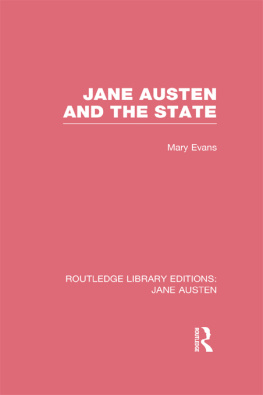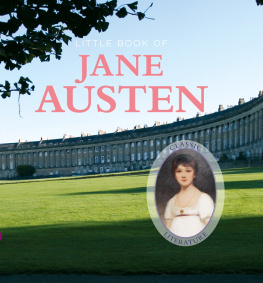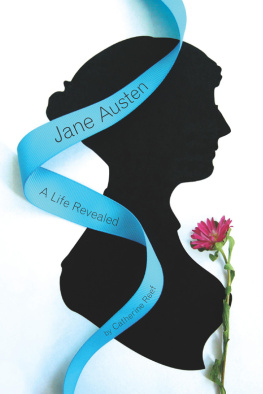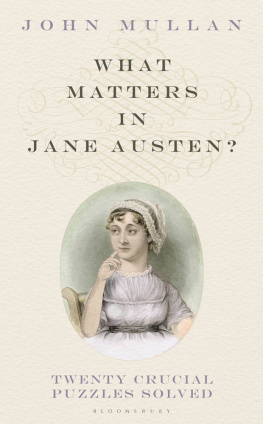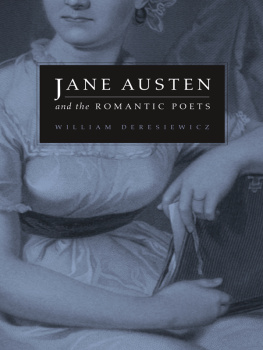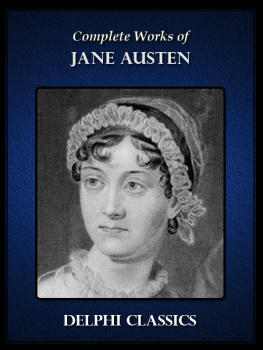Ennos - Jane Austen A New Revelation
Here you can read online Ennos - Jane Austen A New Revelation full text of the book (entire story) in english for free. Download pdf and epub, get meaning, cover and reviews about this ebook. City: Molesey, year: 2013;2017, publisher: Senesino Books Limited, genre: Non-fiction. Description of the work, (preface) as well as reviews are available. Best literature library LitArk.com created for fans of good reading and offers a wide selection of genres:
Romance novel
Science fiction
Adventure
Detective
Science
History
Home and family
Prose
Art
Politics
Computer
Non-fiction
Religion
Business
Children
Humor
Choose a favorite category and find really read worthwhile books. Enjoy immersion in the world of imagination, feel the emotions of the characters or learn something new for yourself, make an fascinating discovery.
- Book:Jane Austen A New Revelation
- Author:
- Publisher:Senesino Books Limited
- Genre:
- Year:2013;2017
- City:Molesey
- Rating:5 / 5
- Favourites:Add to favourites
- Your mark:
- 100
- 1
- 2
- 3
- 4
- 5
Jane Austen A New Revelation: summary, description and annotation
We offer to read an annotation, description, summary or preface (depends on what the author of the book "Jane Austen A New Revelation" wrote himself). If you haven't found the necessary information about the book — write in the comments, we will try to find it.
The first book to reveal the true author of the works of Jane Austen.
Ennos: author's other books
Who wrote Jane Austen A New Revelation? Find out the surname, the name of the author of the book and a list of all author's works by series.
Jane Austen A New Revelation — read online for free the complete book (whole text) full work
Below is the text of the book, divided by pages. System saving the place of the last page read, allows you to conveniently read the book "Jane Austen A New Revelation" online for free, without having to search again every time where you left off. Put a bookmark, and you can go to the page where you finished reading at any time.
Font size:
Interval:
Bookmark:

Copyright 2013 Senesino Books Limited
Cover Illustration Sarah Siddons as the Tragic Muse by Sir Joshua Reynolds
Courtesy of the Huntington Art Collections, San Marino, California.
The moral right of the author has been asserted.
Apart from any fair dealing for the purposes of research or private study, or criticism or review, as permitted under the Copyright, Designs and Patents Act 1988, this publication may only be reproduced, stored or transmitted, in any form or by any means, with the prior permission in writing of the publishers, or in the case of reprographic reproduction in accordance with the terms of licences issued by the Copyright Licensing Agency. Enquiries concerning reproduction outside those terms should be sent to the publishers.
Senesino Books Limited
31 Sackville Street
Manchester
M1 3LZ
ISBN 9780957687011
British Library Cataloguing in Publication Data.
A catalogue record for this book is available from the British Library.
TO MITYA
Mindenemet magammal hordozom.
s ami enym volt, enym marad
Innen is, tl is a csillagokon,
Mert llek vagyok, vgtelen, szabad.
Bennem elfrnek mind, kik rmhajoltak,
A fk, s a lombok s az aluv rt,
Bennem elfrnek az lk s a holtak.
All that I have I bring with me
And all that was mine stays with me
Here on earth and beyond the stars
For my soul is free and without end
In it there is room for all who leaned on me
The leafy trees and the sleepy meadows
In it there is room for the living and the dead
(Sndor Remnyik)
Acknowledgements
Firstly, I would like to thank my wife Larisa for all her help and support with this project, including her pencil illustrations.
Secondly, I would like to thank all those who gave me permission to use parts of their work in this book, and to reproduce their illustrations and paintings. In particular, I would like to thank David Gilson and Peter Jones, Librarian of Kings College, Cambridge for the use of the poem by James Austen. I have used my best endeavours to contact everyone I can to obtain permissions for any quotations and would welcome any correspondence from those who I have been unable to contact.
I would like to apologise for the lack of footnote references or superscript numbers, although full references, for those who would like them, are given for all quotations in the bibliography. This is something that I feel strongly about.
I would wish to return to the former practice that read non-fiction as literature, rather than academic research. Lately literature has become increasingly corralled within that by now rather tired form, the unaptly named novel. Another consideration is that I have written my book for the intelligent reader rather than the academic. A further justification is that the presence of footnotes or reference numbers can lend a spurious air of authority to even the most outrageous falsehoods.
Apology
Tuon aber ich diu gelche nuo
und schepfe mniu wort dar zuo,
daz mir ir iegelches sage
von disem maere missehage,
so wirbe ich anders, danne ich sol.
ich entuon es niht: s sprchen wol
und niwan z edelem muote
mir unde der werlt ze guote.
binamen si tten ez in guot.
und swaz der man in guot getuot,
daz ist ouch guot und wol getn.
aber als ich gesprochen hn,
daz s niht rehte haben gelesen,
daz ist, als ich iu sage, gewesen:
But were I now to do the same
And in this book of mine should claim
That every word of theirs they write
Is not pleasing in my sight
I would act wrongly, truth to tell
I wont do this: for they wrote well
And their intentions, as they understood
Were only for mine and for the worlds good.
No doubt they wrote in good faith for us
And anything which a man does thus
Is also good, nobly done and sincere
But as I have already made it clear
What they have written is untrue
This is the case, as I have told it you.
(Gottfried von Straburg, Tristan)
1.
Introduction
Ich hn mir eine unmezekeit
der werlt ze liebe vr geleit
und edelen herzen zeiner hage,
den herzen, den ich herze trage,
der werlde, in die mn herze siht.
ine meine ir aller werlde niht
als die, von der ich hoere sagen,
diu keine swaere enmge getragen
und niwan in vruden welle sweben.
die lze ouch got mit vruden leben!
Der werlde und diseme lebene
enkumt mn rede niht ebene.
An endeavour I have undertook
Set out in this my modest book
Of the world to please the better part,
To bring solace to their noble heart
The world over which my heart has charge
This part but not the world at large
Like those of whom Ive heard it said
Believe everything that they have read.
Their only wish in life is this:
To remain happy in their ignorant bliss.
Of their world here you will not find a trace
I gladly leave them to Gods grace!
(Gottfried von Straburg, Tristan)
Literary biography is the illegitimate child of biography and literary criticism. The literary biographer is faced on the one hand with the life of the writer and, on the other, their works. Literary biography is the attempt to shoehorn the one into the other. Whilst literacy criticism is an art using the highest intellectual powers to investigate the works of the author, identification of the author usually consists of nothing more than a cursory inspection of the flyleaf.
To me it is incontestable that the great works of these two authors, Fanny Burney, who has been called by Virginia Woolf The mother of English fiction, and Jane Austen, compared by Thomas Babington Macaulay and George Henry Lewes to a prose Shakespeare, were the work of one and the same directing mind, a woman of outstanding genius who was forced to remain anonymous during her lifetime, but whose genius and generosity were reflected in her colourful and eventful life.
This book is written for those people with enquiring minds who wish to discover the life of this woman and to look for her reflection in the great works that she left behind her, which were to revolutionise literature, create the modern novel and reward readers of future times with a legacy of literary masterpieces. Once a biographer is no longer burdened with the task of describing the inconsequential and uneventful lives of Jane Austen and Fanny Burney, he is free to open up vistas revealing the creative mind that lay behind these works of genius.
2.
The Authorship Problem
Ir ist s vil, die des nu pflegent,
daz si daz guote zbele wegent,
daz bel wider ze guote wegent:
die pflegent niht, si widerpflegent
So many critics now we read
That judge whats good as bad, indeed,
The bad, in turn, to good transmute
They bring critics into disrepute.
(Gottfried von Straburg, Tristan)
Brian Dillon in his essay Circumventing the Biographical Subject: Jane Austen and the Critics states that the evidence on which biographers have connected the life of Jane Austen to the books which bear her name is extremely flimsy. He writes that the existing material relating to Jane Austens biography is relatively slight, consisting merely of a volume of censored letters, a brief biographical statement penned by one of her brothers a year after her death, a memoir by a nephew recollected in tranquility over half a century after her death. He says that readers often wonder how this simplified biographical subject could have authored such powerful, challenging novels. In particular he notes that Readers are often troubled by the apparent gap between her life and her art when it comes to the issue of marriage. Could the author of
Next pageFont size:
Interval:
Bookmark:
Similar books «Jane Austen A New Revelation»
Look at similar books to Jane Austen A New Revelation. We have selected literature similar in name and meaning in the hope of providing readers with more options to find new, interesting, not yet read works.
Discussion, reviews of the book Jane Austen A New Revelation and just readers' own opinions. Leave your comments, write what you think about the work, its meaning or the main characters. Specify what exactly you liked and what you didn't like, and why you think so.




